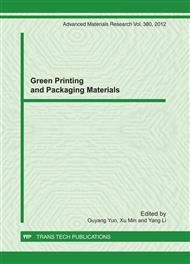p.230
p.234
p.238
p.244
p.248
p.254
p.260
p.265
p.270
Effect of Oxygen Scavenging Packaging on Orange Juice Quality
Abstract:
Physical and chemical quality including vitamin C, TSS, browning index and pH and sensory quality indexes including appearance, color and odor of orange juice were studied during the storage under ambient temperature, take oxygen scavenging films (OSF) as the packaging materials, and high barrier packaging and normal food packaging as the control group. Experimental results showed vitamin C, total soluble solid and pH value of orange juice packed in oxygen scavenging packaging were higher than that in control group, browning index was significantly lower than that in control group, and the sensory quality evaluation was better than that in control group after storage for 5 weeks. This indicated that oxygen scavenging packaging can remove oxygen in package headspace, prevent oxygen from penetrating into package from outside, and form a lower oxygen concentration environment in package. And it can obviously retard the degradation of vitamin C and sugar, delay the browning, delay the decline of orange juice quality, and prolong the shelf life of orange juice.
Info:
Periodical:
Pages:
248-253
Citation:
Online since:
November 2011
Authors:
Price:
Сopyright:
© 2012 Trans Tech Publications Ltd. All Rights Reserved
Share:
Citation:


